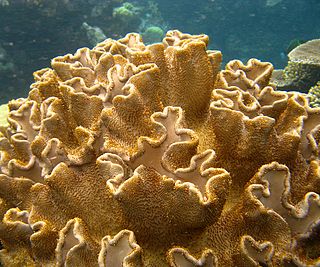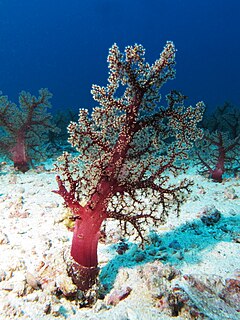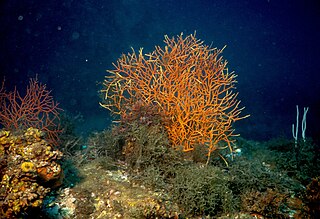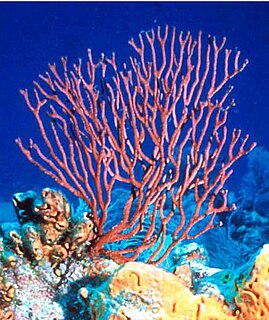The Percopsiformes are a small order of ray-finned fishes, comprising the trout-perch and its allies. It contains just ten extant species, grouped into seven genera and three families. Five of these genera are monotypic

The Squaliformes are an order of sharks that includes about 126 species in seven families.

Xenia is a genus of photosynthetic soft marine coral in the family Xeniidae. They resemble a mushroom, with "arms" coming out from the top that end in many-fingered "hands". It is unique among corals because of its ability to use its "hands" to "pulse" or push water away from the colony in a constant, grabbing motion. Common names include fast-pulse Xenia. Species of Xenia are sometimes referred to as pulse corals.

Alcyoniidae is a family of leathery or soft corals in the phylum Cnidaria.

Melithaea is a genus of octocorals in the family Melithaeidae. Members of the genus are commonly known as fan corals and are found in the tropical Indo-Pacific region. The type species is Melithaea ochracea.

Dendronephthya is a genus of soft corals in the family Nephtheidae. There are over 250 described species in this genus. They are sometimes kept in aquariums, but are notoriously difficult to keep, requiring a near constant supply of small foods such as phytoplankton.

Leptogorgia is a genus of soft coral in the family Gorgoniidae. The genus has a widespread distribution with members being found in the eastern Atlantic Ocean from Western Europe to South Africa, the Mediterranean Sea, the Atlantic coasts of North and South America, the Antilles and the Pacific coast of America. Species are found in both shallow and deep waters.

Alcyonium is a genus of soft corals in the family Alcyoniidae.

Sinularia is a genus of soft coral in the family Alcyoniidae. They are commonly known as leather corals and currently have 166 described species in the genus.

Virgularia is a genus of sea pen in the family Virgulariidae.

Cavernularia obesa is a species of marine cnidarians in the family Veretillidae.

Clavularia is a genus of corals in the family Clavulariidae. They are often referred by the common names star polyps or clove polyps.
Cavernularia elegans is a species of coral in the family Veretillidae found in the North Atlantic Ocean.

Veretillidae is a family of sea pens.

Iciligorgia is a genus of soft coral in the family Anthothelidae.

Sarcophyton is a genus of corals in the family Alcyoniidae that are commonly kept in reef aquaria.
Stachyptilum is a genus in the family Stachyptilidae. The genus contains bioluminescent species.

Veretillum is a genus in the family Veretillidae. The genus contains bioluminescent species.
Paralemnalia is a genus of corals belonging to the family Nephtheidae.















